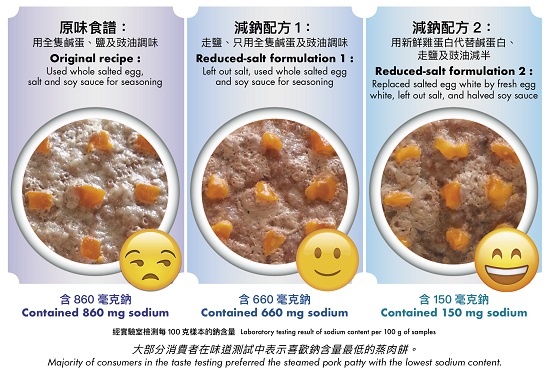
Food Safety Focus (137th Issue, December 2017) – Incident in Focus
Sodium Content of Hong Kong Style Savoury Dishes
Reported by Ms. Joey KWOK, Scientific Officer
Risk Assessment Section,
Centre for Food Safety
On 15 November 2017, the Centre for Food Safety (CFS) and the Consumer Council announced the results of a joint study which examined the nutrient content of Hong Kong style savoury dishes, some of which are considered signature of our local cuisine. Shortly afterwards, the Department of Health also released the report of Population Health Survey 2014/15 which revealed that the daily salt intake among local persons aged 15 to 84 was 8.8 g (about 3520 mg of sodium), a level which is well above the World Health Organization (WHO) recommended daily limit. Excessive intake of sodium may increase the risk of developing high blood pressure, and untreated high blood pressure can lead to heart attack, stroke and kidney failure, etc. This article highlights some key results on sodium in the dishes and urges the trade to take prompt actions to address this important public health issue.
The Study
Ten samples for each of the 10 types of Hong Kong style savoury dishes had been collected from Chinese restaurants, local style cafes and fast-food chains in the local market, and tested for the contents of sodium and other nutrients.
“Steamed minced pork patty with salted egg” was found to contain the highest mean sodium content per 100 g, of which three samples were considered high in sodium content, i.e. containing more than 600 mg per 100 g of food. The sample with the highest sodium content (i.e. 730 mg/100 g) contained three times as much sodium as the sample with the lowest sodium content (i.e. 240 mg/100g), reflecting that it is feasible for the trade to reduce sodium content in this particular dish.
The study also simulated different scenarios of eating out in local food premises. Remarkably, it was revealed that even with different combinations of dishes, the sodium intake for the whole meal per person would still far exceed one-third of WHO’s recommendation on daily intake upper limit for sodium (i.e. 2000 mg per day for adults, or less than 5 g of salt per day). Again, this signifies that the trade needs to reduce sodium content of Hong Kong style savoury dishes through recipe modification, so that members of the public can reduce their sodium intake gradually when eating out.
In view of the study results, some restaurants involved in this study responded positively that they would consider taking measures such as strengthening communication with chefs and relevant staff training, and would seek actively to modify recipes for continue improvement of sodium content in food.
Practical Ways to Reduce Sodium Content in Hong Kong Style Savoury Dishes
The dish “steamed minced pork patty with salted egg” is used here for illustration purpose. The major sources of sodium in this dish come from: (i) salted egg, especially egg white; (ii) salt and condiments for marinating; and (iii) extra soy sauce may be added before serving. Knowing where the sodium comes from, professional chefs and consumers at home can exercise creativity to modify their recipes with a view to cutting down sodium content of the dish whilst maintaining a tasty final product. Indeed, the CFS has conducted a taste testing on steamed pork patties with different sodium contents earlier on (see illustration), and it was encouraging to find that the majority of participating consumers had shown preference for the patty with the lowest sodium content.
Key Points to Note:
- According to the findings, when consumers are having a meal of Hong Kong style savoury dishes in local food premises, the sodium intake is likely to exceed one-third of WHO’s daily recommendation.
- The trade should be aware that sodium content in food on sale has public health implications, and they should take prompt action to address this important public health issue.
- Consumers nowadays may actually welcome and prefer dishes to be less salty.
Advice to the Trade
- Reduce the use of salt and condiments (e.g. soy sauce, oyster sauce, chicken powder) during marinating and cooking steps; use more herbs and spices (e.g. ginger, spring onion, garlic) instead for seasoning.
- Reduce the amount of sauce in dishes, and serve sauce and condiments in separate containers.
- Make reference to the CFS’ “Trade Guidelines for Reducing Sodium in Foods” for producing food with lower sodium content.
Advice to the Public
- Ask for "less salt" and "less gravy" dishes when ordering.
- Request soy sauce or other condiments to be served separately, and taste before adding them.
- When cooking at home, reduce the use of salt and condiments to cut down sodium content of dishes.


